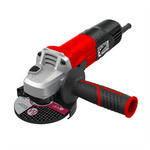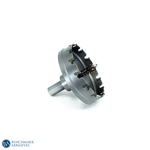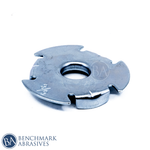
From Sandpaper To Sanding Disc: A Historical Overview

The simple process of smoothing a surface has a rich and compelling history filled with an ongoing quest for efficiency and precision. This investigation explores the development of abrasive technology over time, from the ancient uses of natural abrasives in the form of "sandpaper" to the advanced sanding discs that rule contemporary industries.
We are going to discuss the significant turning points that fueled this change, which was fueled by both the need for better finishing and industrial improvements. This historical viewpoint brings light to an important period in the evolution of material processing and surface preparation, from the hand-applied grit of early sandpaper to the power-tool compatible accuracy of sanding discs.
The Origins of Sandpaper: A Primitive Tool
The idea of using abrasive materials for smoothing surfaces has existed since ancient times. Earlier, sandpaper was made using natural materials. The Egyptians, Greeks, and Romans used materials that included sand, pumice, and emery in their crafting processes of Ancient Civilization. Abrasive stones were used to shape tools and materials, while loose sand was used for projects including pottery and metal finishing. The first recorded example of manufactured sandpaper appeared in 13th-century China, when crushed shells, seeds, and sand were stuck to the parchment using natural gums, which was shown as an initial concept of blending an abrasive medium with a backing material.
Additionally, different societies found natural abrasives on their own, including shark skin and the rough leaves of horsetail plants, showing humanity's inner desire to smooth and polish surfaces by using readily available resources and offering the primitive foundation for the coated abrasives we use today.
The Industrial Revolution: The Birth of Coated Abrasives
The increasing demands of the Industrial Revolution acted as an essential catalyst in the emergence of abrasive technology, which entailed more efficient and reliable surface preparation techniques. As mass manufacturing spread throughout different sectors, the downsides of conventional hand-applied abrasives became increasingly apparent.
This century saw the genuine invention of coated abrasives, indicating a dramatic shift away from entirely natural ways of smoothing.
The initial attempts to glue abrasive particles to flexible backings took place in the late 18th century, essentially by fixing grains onto paper or cloth using natural glues. When specialized sandpaper manufacture was established in the early 19th century, this emerging technique began to acquire commercial momentum. onto paper or cloth.
In London by 1833, a shift towards more standardized and regulated abrasive materials was marked by the mass production of “glass paper,” which used crushed glass particles as abrasives. The final date of the first US patent for a sandpaper manufacturing process necessitated more precise research (a general search showed a patent in 1932, implying earlier methods were possibly unpatented or records are less readily available). The early to mid-19th century undoubtedly labeled the pivotal period when sandpaper moved from a primarily artisanal craft to an emerging industrial product, laying the groundwork for subsequent developments in coated abrasives.
Improvements in the Technology of Sandpaper
The 19th and early 20th centuries witnessed major improvements in sandpaper. This includes:
- New Abrasive Materials: Natural abrasives, including garnet and emery, were joined by Synthetic materials, including silicon carbide, which was found in the late 19th century, and aluminum oxide, which was found in the early 20th century. These synthetic abrasives delivered outstanding durability, cutting power, and toughness.
- Superior backing and Adhesives: To bind the abrasive grains together, more robust paper and cloth backings were created in addition to more sturdy and long-lasting adhesives.
- Specialized sandpaper: These sandpapers were introduced in 1921. Waterproof sandpaper, also popularly known as wet and dry, is sometimes used with lubricants like water to eliminate dirt and avoid clogging. Also, stearated sandpaper with a dry lubricant was invented to avoid clogging while sanding paint and finishes.
INTRODUCTION OF SANDING DISCS
Although sandpaper sheets were highly efficient for hand sanding and some early power tools, the increase in rotary power tools generated a need for a more versatile abrasive. Sanding discs came into vogue in the mid-20th century. Earlier, these were basic round pieces of coated abrasive material that could be fastened to revolving tools. This change holds various benefits over conventional sheets by offering greater stability and control during operation, especially at higher speeds.
By inserting the abrasive particles onto a hard disc, users can achieve more uniform material removal and smoother finishes, mainly when using the growing power and rotational force of tools, including orbital sanders and disc sanders. This breakthrough opened the door for more disc design and functionality improvements and marked a major advancement in the optimization of abrasive technology for powered applications.
ADDITIONAL DEVELOPMENTS IN SANDING DISCS
The design and features of sanding discs continued to evolve, which include:
- Hook & Loop fastening: The late 20th century witnessed the development of hook and loop technologies, which altered disc attachment and removal, resulting in a simple and faster procedure.
- Advanced abrasive materials: Modern sanding disc uses a wide range of high-performance abrasives, which include:
-
- Ceramic Abrasives: Perfectly suitable for hard materials due to their outstanding hardness and durability
- Silicon Carbide: Suitable for hard surfaces like glass and stone
- Zirconia: suitable for heavy-duty tasks as they are highly durable and aggressive.
- Aluminum Oxide: Suitable for general-purpose sanding, as this abrasive is commonly used and highly flexible.
- Dust Extraction: When used with power sanders that have vacuum systems, perforated sanding discs with holes or slots were created to enhance dust collection, creating safer and cleaner working conditions.
- Specialized Discs: Different types of sanding discs have been created for particular applications, like flap discs for grinding and blending, and surface conditioning discs for finishing.
IMPACT AND THE FUTURE OF SANDPAPER
The shift from sandpaper to sanding discs has had an intense and worldwide impact across various sectors, revolutionizing surface preparation in the woodworking, metalworking, construction, automotive, and DIY sectors. Sanding discs, especially when used with power tools, provide dramatically enhanced efficiency through rapid material removal and are capable of covering wider surface areas more quickly.
They also deliver improved accuracy and control, which results in more stable and higher-quality finishes when compared to hand sanding with sheets. Because of their flexibility with different power tools and the abundance of abrasive materials and grits, sanding discs are an essential tool for a variety of activities, from rough shaping to fine polishing.
When we talk about the future, the field of abrasive technology, which includes sanding discs, continues to develop with a strong focus on certain key areas. The creation of more robust and effective abrasive grains, such as advanced ceramics and superabrasives, which have a greater lifespan and better cutting ability, is a result of advances in material science. There's also an increasing focus on sustainability as makers explore eco-friendly bonding agents by using recycled materials in backings and creating abrasives that are capable of minimizing waste. Improved dust extraction capabilities are one of the innovations in disc design that make workplaces healthier and cleaner.
Additionally, sanding procedures are starting to be impacted by the integration of automation and smart technologies; sensors and artificial intelligence may optimize sanding settings for various materials and applications. More customized sanding solutions catered to particular industry requirements are probably in store for the future, coupled with a persistent push for increased productivity, environmental responsibility, and user safety.



































































